Many people use the words “antlers” and “horns” interchangeably as if they’re the same thing. They are not. Yesterday’s post about the pronghorn with deformed horns prompted several requests that I cover the differences between antlers and horns and this post is my response.
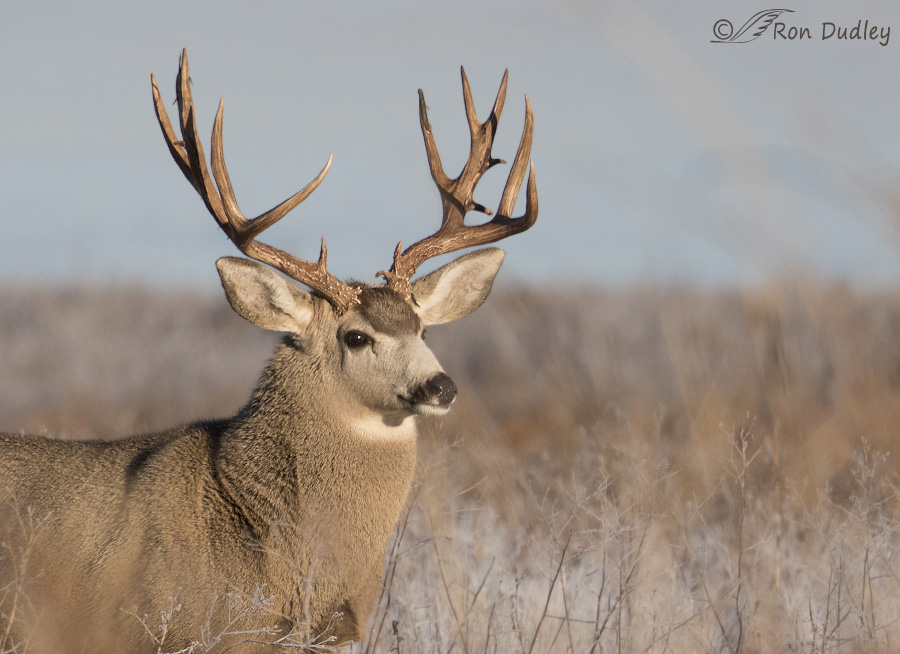
Antlers are found on members of the deer family (Cervidae) – all species of deer, moose and elk. This mule deer buck with his neck swollen for the rut has a handsome rack of antlers, not horns.
Antlers:
- are made of bone and found only on males (with the exception of caribou where females also have small ones)
- are grown every spring and shed every winter (with very few exceptions including a couple of small tropical deer species that don’t shed them)
- are typically branched
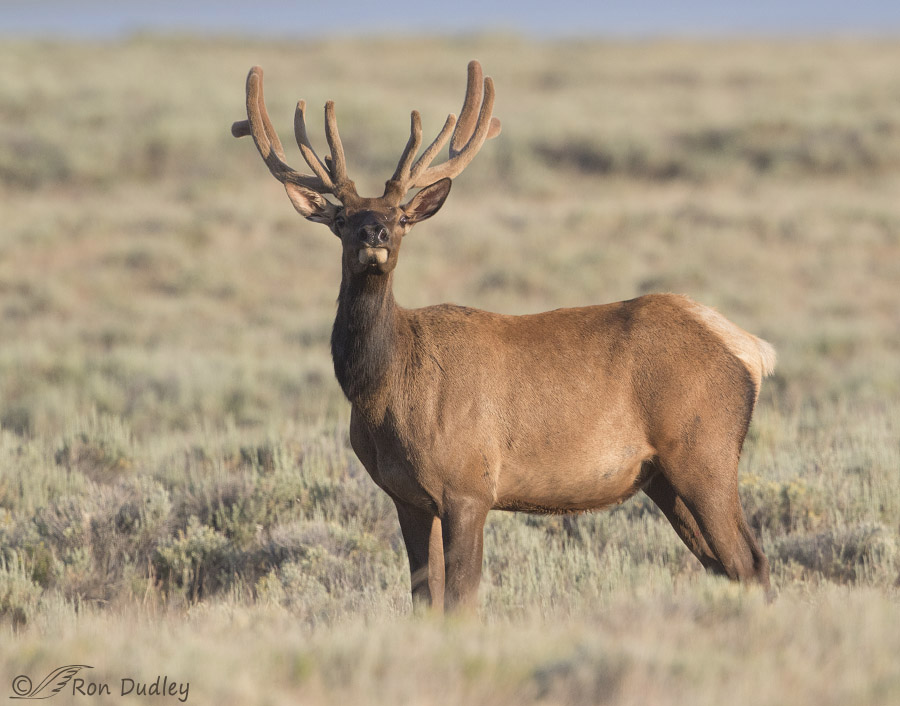
This is a bull elk whose still-growing antlers are covered in velvet which carries blood and nutrients to the growing antlers. When the antlers reach full size the velvet dies and is shed leaving the mature antlers behind.
Horned mammals never have velvet.
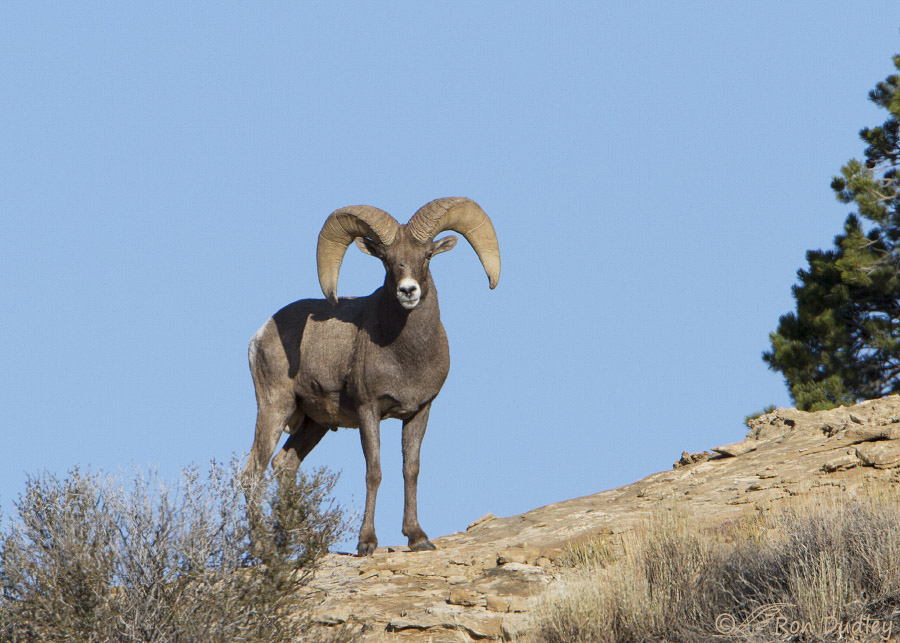
Horns are found on members of family Bovidae, the cloven hoofed ruminants, including cattle, bison, water buffalo, antelope, sheep, goats and muskoxen. I think readers will agree that this male desert bighorn sheep has spectacular horns.
Horns:
- have a bony core but are covered with a thick sheath of keratin (the protein that hair, fingernails and hooves are made of). It’s the keratin that we actually see.
- most horns are never branched, are never shed and grow throughout the life of the animal
- are typically found on both males and females though they’re much smaller on females
- shape and size varies considerably
So an adult horned mammal of either sex will always have its horns while antlered mammals only have antlers in season (usually) and only on males (usually).
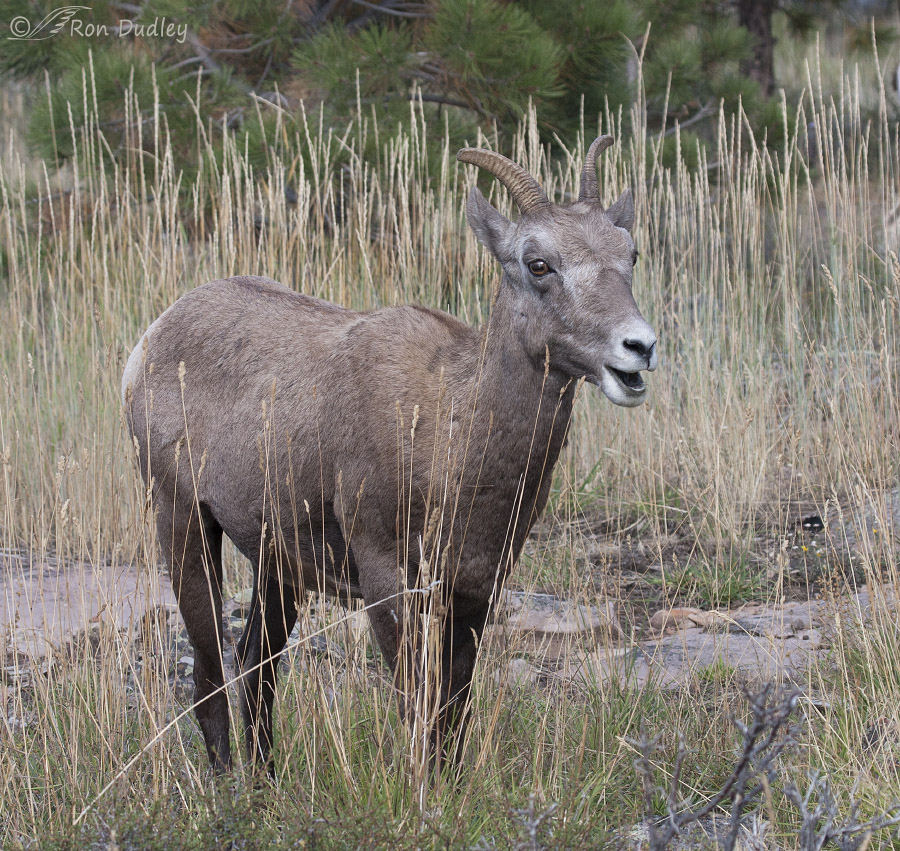
This female bighorn sheep is an example of a female having smaller horns.
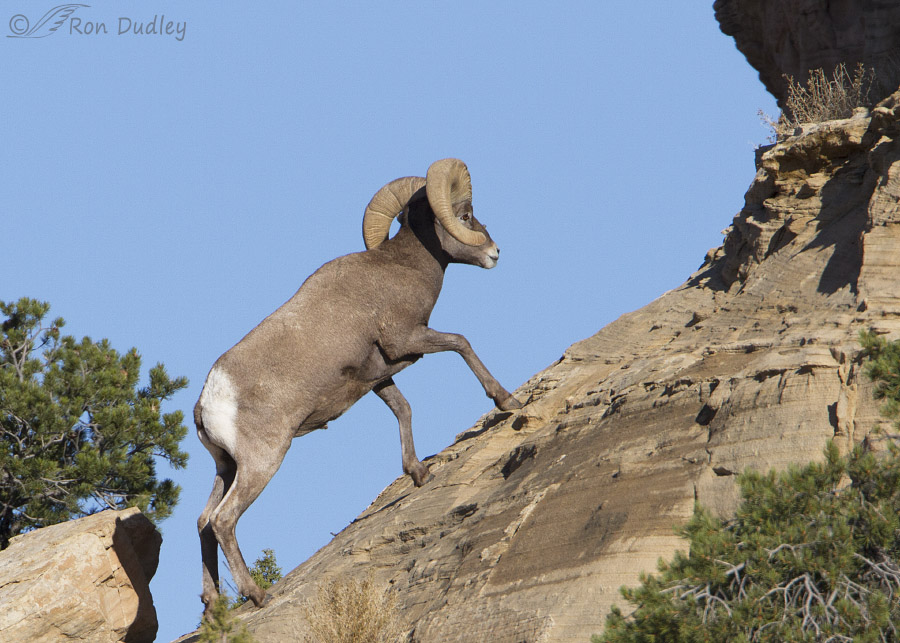
Male bighorns can actually be aged by counting the growth rings (annuli) on their horns. At this angle we can see three distinct growth rings on his left horn. Determining age accurately is just a little bit tricky but if you’re interested in how it’s done you may want to visit this link.
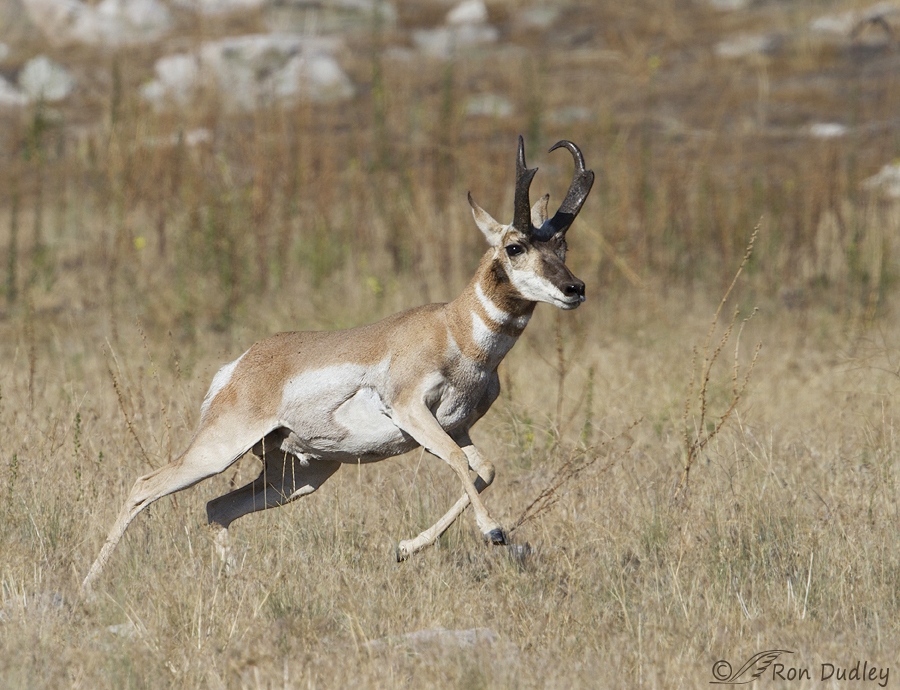
There are a few minor exceptions to some of the “rules” I’ve provided above and the pronghorn is one of them. Pronghorns have horns (made of keratin) but like antlers they’re shed annually and regrown, leaving the bony core behind in the interim.
Pronghorns are commonly and incorrectly called antelope (witness Antelope Island and Home On The Range – “where the deer and the antelope play”) but they aren’t at all closely related to true antelope which are all native to the Old World. Pronghorns are the only surviving members of family Antilocapridae and their closest living relatives are the giraffes and okapi of Africa.
Ok, I’ve probably beaten this antler vs. horn thing to death but that distinction has always been an important one for me. Anyone who ever took my Utah wildlife or zoology classes at South High School and then Highland High School definitely knew the difference(s) before they passed my class!
Ron


Somehow I never got to me email yesterday! Almost missed this wonderful lesson, one I never learned in any of my biology classes. When I was reading about the antlers, the information reminded me of deciduous trees/shrubs. Some of the ones we have here will hold onto their leaves beyond the usual time if it’s warmer (thinking of the tropical deer). The pronghorn makes me wonder if giraffes shed their horns…
Great post, Ron! Thanks so much. Found myself (once again) wishing I’d been a student in your classes when I was in High School…but, better late than never!
Thanks so much for the lesson. I appreciate it. I always thought that the word antler and horn were interchangeable.
Fascinating & love the learning – I’d no idea about the Pronghorns, but then I’m an ‘Easterner’
Thanks, Hila. You should come out west and check them out sometime…
Fascinating! I did know the difference but did not know the Pronghorns shed! I also have recently learned that here in New Mexico there is a wild population of ibex (who have horns. 😀 )
Yes, and Ibex horns can be extremely impressive on the males. I believe they’re a type of goat.
Question: does all this mean National Velvet was not horny???
May I horn iin here?…Just wanted to say “thanks” …and “very interesting”…Sooo, buffalo, bison, rhinos and cattle,sheep, prongs, jackalopes and goats have horns…elk, deer, and moose have antlers…where does that leave giraffes???
I think I goofed on “jackalopes”…I think they have antlers and giraffes have horns…better?
Patty, Giraffes have ossicones – made of ossified cartilage covered with skin. FYI – the “horns” of rhinos are made completely out of keratin – no bone.
Got it…Thanks…I wondered about those two…that leaves only jackalopes…..
Re: Rhino horns. That they’re made of keratin makes me wonder where the heck folks get the idea that rhino horns can be a sex tool! WHAT? Come on folks–common sense. Use it!
I’ll let you do the research on jackalopes, Patty. I know where there’s a stuffed one in a Montana bar near Glacier Park if you decide to do some field research…
I LOVE learning new things every day! THANK YOU yet again Teacher Ron!! If I’d have taken your class, my life would probably have turned out differently. Instead, my teacher in the sciences was a dirty old man, interested more in what he could see from the females wearing skirts/dresses than he was with teaching anything! That was NOT a good start for me. I’m still catching up from that old fart! Sigh!
I hate to hear that about any teacher, Laura, but especially one in the sciences. Good teachers can make such a positive difference in the lives of students but the effect of teachers like you describe can be just as negative as the others are positive.
You’re absolutely right! He turned me away from sciences for a LONG time until I realized that it wasn’t about him. But I’m catching up. Thanks to my father, I follow my curiosity and it’s seemingly boundless. I’ve also been blessed with a mind that says, “Oh there’s a word! Let’s read it!” Sometimes it’s non-productive (billboards, license plates, etc.) but there are all these books available and they’re just FILLED with words and new ideas 🙂 YIPPEE! Now the challenge is to remember what I’ve learned…LOL!
Oh Laura. What a waste. A ‘teacher’ who was more concerned with his libido than sharing knowledge doesn’t deserve the name. Our final year science teacher (female) spent the year on a personal crusade demonstrating ‘personal space’ issues by crowding us to one end of the shared benches. Decades later my anger hasn’t died.
And huge thanks to Ron. Who is and was a teacher. With a classroom bigger (and probably) more grateful than any he could have imagined while he was being paid for his work.
Thanks so much, EC.
🙂
I got a lot of late starts around education. I ended up quitting high school, BUT when I went to work for a company that would pay for college expenses, I got my GED and took advantage of that. I didn’t finish until 2005 (undergrad) because I took classes all over the country–every time life settled down, I took more classes (boredom is NOT for me!). Finally, we stitched the closest available graduation route (the classes were highly varied depending on diverse interests). I ended up with English as the fastest route to graduation with a concentration in Native American Literature. THEN, I did graduate school, American History with a concentration on Native American history.
I’m thinking seriously about doing a doctoral program. It won’t earn me any money, but as long as I’m hanging out on this spinning rock, twiddling my thumbs on this side of the dirt, why NOT? I’m not dead yet! 🙂
Thank you for this very informative and picturesque article. I’ve learned just enough on this subject to make me want to explore more. Hopefully I would have passed your exams and graduated as well. Feel lucky to have you around, Ron and lucky that Neil told me about you.
Thank you so much,
Glad to have you around, Alice. And thanks to Neil for pointing you my way.
Thanks, Ron. Great explanation. I’m sure you know, but for your readers, pronghorn are also the only horned mammals that have branched horns. I haven’t seen the deformed buck for a couple of years either. I like your name–I called him “Twisty”.
Ha, Twisty works well too, Larry!
I probably enjoyed this posting of your Ron as much as any other. Thank you for the explaination on the fact we no longer have antelope in Norah America.
I will cut and paste that eye-opening bit of history on my site. Must be cooling down where you live right now. Do you ever take photographers on a guided
Tour? Linda
Thank you, Linda. It has been cooling down nicely over the last couple of weeks and no, I’m afraid I don’t do tours.
Not even if we wash your truck and buy you donuts from the good donut place? 😉
Ha, washing my truck (and actually getting it clean) would be a much bigger job than you think!
Steel wool? 😉
Great explanation Ron, very clear and it answered many of my questions. Thank you. I could not help drooling as I looked at these images too! You have some stellar photographs of some very impressive examples of the species! Made my day, thanks!
Thanks very much on both counts, Ed. And for part of the inspiration for this post! 🙂
Such beautiful photos and such a clear explanation. Thank you, Ron
Elizabeth
I especially appreciate that “clear explanation” part of your comment, Elizabeth.
Marvelous shots Ron! Always the educator 🤗
Charlotte!
Thank you, Charlotte.
Excellent, Excellent post Ron! Love the detail with the images! Your blog is awesome! I basically was aware of the differences between antlers and horns, but this lesson was great! Many thanks!
That first image is fantastic, I had never seen a buck in rut, although I knew their neck got larger, never realized how big it got! Man that Mule Deer’s neck is big!
And, thanks to Marty for his information!
Thanks, Dick. I think the combination of the swollen neck and impressive antlers makes them look majestic.
Agreed!
Very good and Thx, Ron! I’ve never paid that much attention to the Pronghorns except to note there seems to be “horns” all year long – more concerned about them turning as a group to cross the road or just one racing you down the road. Caribou info is also interesting D.
Yes, they’re very unpredictable near a road. You never know which direction they will run and they’re VERY fast! Thanks, Judy.
Thank You for sharing this information. And, I never knew a Pronghorn was in the same family as Giraffe.
Thanks, LS. Actually they’re not in the same family (pronghorn are the only mammals in that family) but giraffes and okapi are their closest living relatives.
Another great lesson, Teech. I’m especially drawn to Mr. Velvet, the elk. I’ve had several opportunities to touch still-growing antlers and there’s not much else that feels like that living velvet. And again, totally different once it has been scraped off against a tree or rocks when I found pieces as a kid. I’m once again reminded just how lucky I was that my dad was a trail teacher and I got to grow up in the mountains for a couple years.
I’ve never touched living velvet, Marty. Would love to one day…
It helped that my dad “knew a guy who knew a guy” (and, of course, that I was my dad’s favorite daughter — my sisters weren’t into “nature stuff” at all).
Thank you for this interesting lesson 🙂
I guess I always knew the difference, but didn’t know all the details. In these parts (Eastern Canada) we don’t have any “horned” wildlife, just “antlered” moose, caribou, and white-tailed deer.
Another interesting fact about female caribou, is that they often carry their antlers through the winter to spring, until after they give birth to their calves (males shed theirs in the fall).
I bet most people didn’t know that Santa’s reindeer are actually female!!
Thanks for providing that interesting tidbit about female caribou, D.
I always figured they were female because they do all the work. Tee hee. 😉